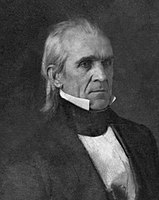
Back انتخابات الرئاسة الأمريكية 1844 Arabic ھەڵبژاردنی سەرۆکایەتیی ویلایەتە یەکگرتووەکانی ئەمریکا (١٨٤٤) CKB Præsidentvalget i USA 1844 Danish Präsidentschaftswahl in den Vereinigten Staaten 1844 German Elecciones presidenciales de Estados Unidos de 1844 Spanish Yhdysvaltain presidentinvaalit 1844 Finnish Élection présidentielle américaine de 1844 French הבחירות לנשיאות ארצות הברית 1844 HE Elezioni presidenziali negli Stati Uniti d'America del 1844 Italian 1844年アメリカ合衆国大統領選挙 Japanese
| |||||||||||||||||||||||||||||
275 electoral votes of the Electoral College 138 electoral votes needed to win | |||||||||||||||||||||||||||||
|---|---|---|---|---|---|---|---|---|---|---|---|---|---|---|---|---|---|---|---|---|---|---|---|---|---|---|---|---|---|
| Turnout | 79.2%[1] | ||||||||||||||||||||||||||||
| |||||||||||||||||||||||||||||
 Presidential election results map. Blue denotes states won by Polk/Dallas, Yellow denotes those won by Clay/Frelinghuysen. Numbers indicate the number of electoral votes allotted to each state. | |||||||||||||||||||||||||||||
| |||||||||||||||||||||||||||||
Presidential elections were held in the United States from November 1 to December 4, 1844. Democratic nominee James K. Polk narrowly defeated Whig Henry Clay in a close contest turning on the controversial issues of slavery and the annexation of the Republic of Texas. This is the only election in which both major party nominees served as Speaker of the House at one point, and the first in which neither candidate held elective office at the time.
President John Tyler's pursuit of Texas annexation divided both major parties. Annexation would geographically expand American slavery. It also risked war with Mexico while the United States engaged in sensitive possession and boundary negotiations with Great Britain, which controlled Canada, over Oregon. Texas annexation thus posed both domestic and foreign policy risks. Both major parties had wings in the North and the South, but the possibility of the expansion of slavery threatened a sectional split in each party. Expelled by the Whig Party after vetoing key Whig legislation and lacking a firm political base, Tyler hoped to use the annexation of Texas to win the presidency as an independent or at least to have decisive, pro-Texas influence over the election.
The early leader for the Democratic nomination was former President Martin Van Buren, but his opposition to the annexation of Texas damaged his candidacy. Opposition from former President Andrew Jackson and most Southern delegations, plus a nomination rule change specifically aimed to block him, prevented Van Buren from winning the necessary two-thirds vote of delegates to the 1844 Democratic National Convention. The convention instead chose James K. Polk, former Governor of Tennessee and Speaker. He was the first successful dark horse for the presidency. Polk ran on a platform embracing popular commitment to expansion, often referred to as Manifest Destiny. Tyler dropped out of the race and endorsed Polk. The Whigs nominated Henry Clay, a famous, long-time party leader who was the early favorite but who conspicuously waffled on Texas annexation. Though a Southerner from Kentucky and a slave owner, Clay chose to focus on the risks of annexation while claiming not to oppose it personally. His awkward, repeated attempts to adjust and finesse his position on Texas confused and alienated voters, contrasting negatively with Polk's consistent clarity.
Polk successfully linked the dispute with Britain over Oregon with the Texas issue. The Democratic nominee thus united anti-slavery Northern expansionists, who demanded Oregon, with pro-slavery Southern expansionists who demanded Texas. In the national popular vote, Polk beat Clay by fewer than 40,000 votes, a margin of 1.4%. James G. Birney of the anti-slavery Liberty Party won 2.3% of the vote. Birney's vote share in New York exceeded Polk's margin of victory over Clay, marking the first time a third party candidate affected the outcome of a United States presidential election. After Polk's victory, Tyler annexed Texas, which was the proximate cause of the Mexican–American War during Polk's presidency.
- ^ "National General Election VEP Turnout Rates, 1789-Present". United States Election Project. CQ Press.
- ^ Wilentz, 2008, p. 570: Wright declined: "To do otherwise...would have been a renunciation of both his personal loyalties and his highest principles (The convention settled on the conservative...George M. Dallas)."
Cite error: There are <ref group=lower-alpha> tags or {{efn}} templates on this page, but the references will not show without a {{reflist|group=lower-alpha}} template or {{notelist}} template (see the help page).

